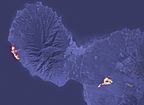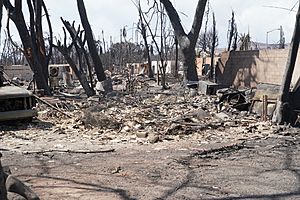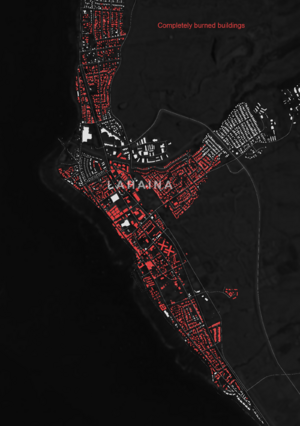2023 Hawaii wildfires facts for kids
Quick facts for kids 2023 Hawaii wildfires |
|
|---|---|
|
From top, left to right: Satellite image of Maui • Lāhainā Banyan Court Park • Front Street • Lāhainā Harbor
|
|
| Location | Hawaiʻi, United States |
| Statistics | |
| Total fires | 4+ |
| Total area | 17,000+ acres (6,880+ ha) |
| Cost | ~$5.52 billion (as of August 11) |
| Date(s) | August 8, 2023 – present |
| Cause | Unknown |
| Buildings destroyed | 2,207 |
| Deaths | 115+ (99% of the Lahaina area searched) |
| Non-fatal injuries | 67+ |
| Missing people | 110 |
In early August 2023, a series of wildfires broke out in the U.S. state of Hawaii, predominantly on the island of Maui. The wind-driven fires prompted evacuations, caused widespread damage, killing at least 115 people and leaving at least 110 others missing in the town of Lahaina, Hawaii. The proliferation of the wildfires was attributed to dry, gusty conditions created by a strong high-pressure area north of Hawaii and Hurricane Dora to the south.
An emergency declaration was signed on August 8, authorizing several actions, including activation of the Hawaii National Guard, appropriate actions by the director of the Hawaii Emergency Management Agency and the Administrator of Emergency Management, and the expenditure of state general revenue funds for relief of conditions created by the fires. By August 9, the state governmenAt of Hawaii issued a state of emergency for the entirety of the state. On August 10, U.S. President Joe Biden issued a federal major disaster declaration.
For the Lahaina fire alone, the Pacific Disaster Center (PDC) and the Federal Emergency Management Agency (FEMA) estimated that over 2,200 buildings had been destroyed, overwhelmingly residential and including many historic landmarks in Lahaina. The damage caused by the fire has been estimated at nearly $6 billion.
Contents
Background
Wildfire risk
The typical area burned by wildfires in Hawaii has increased in recent decades, almost quadrupling. Experts have blamed the increase on the spread of nonnative vegetation and hotter, drier weather due to climate change.
During the 2010s and early 2020s, Clay Trauernicht, a botanist and fire scientist at the University of Hawaiʻi at Mānoa, and several other experts warned that the decline of agriculture in Hawaii meant that large areas of formerly productive land had been left unmanaged; nonnative invasive species like guinea grass were spreading rapidly and increasing the risk of large wildfires. The state government failed to provide incentives or impose mandates to keep land clear of grass. The state government also did not require all structure owners to maintain defensible space, a standard rule in fire-prone states like California. The shrinking of the agricultural workforce reduced overall firefighting capacity; those workers had traditionally suppressed fires on the land they cared for, and were so effective that sometimes the counties called them for help. In 2022, Trauernicht suggested that Hawaii follow Europe's example by subsidizing agriculture as a public good as a form of fire risk reduction. In 2023, UH Manoa biogeography professor Camilo Mora estimated the cost of land restoration to mitigate wildfire risk at about $1 billion. Despite these calls to action, the Hawaii State Legislature had been unable to make much progress; a 2022 bill to spend just $1.5 million on additional fire risk reduction measures died in a legislative committee.
Around the time the fires occurred, twenty percent of the county of Maui was experiencing moderate drought (level 1 of 4), and sixteen percent of the county was under severe drought conditions (level 2 of 4). A decrease in rainfall consistent with the predicted impacts of climate change had also been recorded in the Hawaiian Islands, according to the U.S. National Climate Assessment. In the decades leading up to the fire, overdevelopment practices led to further water management challenges that reduced the availability of water for firefighting and exacerbated drought conditions.
In June 2014, the Hawaii Wildfire Management Organization, a nonprofit organization, prepared a Western Maui Community Wildfire Protection Plan which warned that most of the Lahaina area was at extremely high risk for burning.
In Maui County's 2020 Hazard Mitigation Plan, the county identified Lahaina, the most heavily impacted community in the August fires, as lying within a high risk zone for wildfire.
In its monthly seasonal outlook on August 1, 2023, the National Interagency Fire Center (NIFC) forecast "above normal" potential for significant wildland fires for Hawaii in August, concentrated on the islands' leeward sides. In addition to noting plentiful vegetation growth from the previous wet season and the expanding drought, the NIFC mentioned that "tropical cyclones can also bring windy and dry conditions depending on how they approach the island chain and can exacerbate fire growth potential".
The vulnerability of the islands to deadly wildfires was gravely underestimated in long term assessments. A year prior, the State of Hawaii Comprehensive Emergency Management Plan Report had detailed wildfire risks as one of the lowest threats for the state. A 2021 Maui County assessment acknowledged the spike of wildfires in the state, but described funds as "inadequate" and heavily criticized the county fire department's strategic plan, claiming it said "nothing about what can and should be done to prevent fires."
Weather factors
In early August 2023, a high-pressure system remained north of the Hawaiian Islands. This formed strong surface pressure north of the islands, and also sustained stabilization across the region, creating warm and sunny conditions. Concurrently, Hurricane Dora began to intensify to Category 4 strength, which may have helped to create a large pressure difference between the high-pressure area and the low-pressure cyclone. This pressure difference would have aided in already significant trade winds moving southwest, and formed strong gradient winds over the islands. (A similar phenomenon occurred during the October 2017 Portugal wildfires during the passage of Hurricane Ophelia.) The exact significance of Hurricane Dora and how it impacted the fires themselves remains somewhat unclear. Meteorologists noted that the storm's center remained more than 700 miles (1,100 km) from the islands and that it remained relatively small in size; however it also remained "remarkably potent for a long time", logging more hours as a Category 4 hurricane than any other storm in the Pacific for over 50 years. Philippe Papin, a hurricane specialist with the National Hurricane Center, argued that Hurricane Dora played only a minor role in "enhancing low-level flow over Maui at fire initiation time."
By August 6, the National Weather Service identified a region of very dry air arriving from the East Pacific, greatly inhibiting the potential for rainfall. A prominent descending capping inversion forced even more stabilization of the atmosphere, which led to enhanced wind gusts and very dry conditions between August 7 and 8. As the day progressed, deep layer ridging combined with the existing pressure gradient created very strong wind gusts and caused humidity levels to be well below normal. The aforementioned cap was expected to only strengthen acceleration of wind due to terrain features near the islands.
List of wildfires
| Name | Acres | Start date | Containment state | Date and Ref |
|---|---|---|---|---|
| Olinda | 1,081 | August 8 |
90%
|
September 7 |
| Kula | 202 | August 8 |
95%
|
September 7 |
| Lahaina | 2,170 | August 8 | Fully contained | September 3 |
| Pulehu | 3,268 | August 8 | Fully contained | August 12 |
Impact
The governor of the state of Hawaii, Josh Green, referred to the Lahaina wildfires as the "worst natural disaster" in the history of Hawaii. It is the fifth deadliest wildfire in United States history, and the most lethal wildfire in the country since the Cloquet fire of 1918, which killed 453 people.
Casualties
As of September 4, 2023[update], there were 115 confirmed deaths, and 110 individuals are unaccounted for due to the Lahaina fire on Maui.
Damage
The main Maui wildfire burned much of the community of Lahaina, where more than 2,200 structures were damaged or destroyed, including much of the downtown Lahaina Historic District centered on Front Street. 96% of burned structures were residential. On August 17, Governor Green noted that the fire temperature had reached 1,000 °F (538 °C), since it was hot enough to melt granite counters and engine blocks. Puddles of melted aluminum have been seen underneath burned-out vehicles.
Although PDC and FEMA had initially estimated total damage at around $5.52 billion, catastrophe modeling firm Karen Clark & Co. estimated on August 16 that insured property losses would be only $3.2 billion. Real estate experts expressed concern that many Lahaina homes were uninsured or underinsured and surviving owners might not have sufficient financial resources to build new homes in compliance with the state's current building code. Many Native Hawaiians were able to afford to live in Lahaina only because they had inherited paid-off homes from previous generations, and since they had not needed mortgage loans to purchase their homes, they were not required to carry homeowners insurance coverage.
The Lahaina Historic District, which was designated as a National Historic Landmark in 1962 and was the capital of the Kingdom of Hawaii for 35 years, suffered extensive fire damage. Among the structures destroyed were:
- The Waiola Church, which celebrated its 200th anniversary in May 2023, lost its main sanctuary, annex, and social hall. Waiola Church's cemetery is the burial ground for members of the Hawaiian Royal Family, including Queen Keōpūolani, who founded the church in 1823.
- The Lahaina Jodo Mission, a Buddhist temple in northern Lahaina. Established in 1912 and stood on its current location since 1932.
- The Pioneer Inn, a landmark town hotel constructed by George Alan Freeland in 1901.
- The Nā ʻAikāne Cultural Center, a local cultural center which once housed a soup kitchen for striking plantation workers during an International Longshore and Warehouse Union (ILWU) strike against the Pioneer Mill.
- The Old Lahaina Courthouse, which first operated in 1860 as a customs house for trade and whaling ships. The building's roof was completely destroyed. The Old Lahaina Courthouse stands in heavily damaged Lahaina Banyan Court Park.
- The Lahaina Heritage Museum and its collection, which were housed inside the Old Courthouse building, were also destroyed. The collection included items that spanned Lahaina's history, including artifacts from the area's ancient Hawaiian period, the Hawaiian Kingdom and monarchy, the plantation period, and the town's whaling era. Copies of the museum's documents had been digitized and stored online prior to the fire.
- The Baldwin Home Museum, which was constructed in 1834 and 1835 as the home of American missionaries Dwight Baldwin and Charlotte Fowler Baldwin, burned to the ground. The Baldwin Home was the oldest house on the island of Maui. Historic items lost in the house fire included Baldwin's medical instruments he used to vaccinate much of Maui's population against smallpox in the 1800s, seashell collections, and the family's furniture and rocking chairs from the East Coast.
- The Wo Hing Society Hall, built in the early 1910s to serve the growing Chinese population in Lahaina. It was restored and turned into the Wo Hing Museum in the 1980s.
The fire also destroyed several cell towers in affected areas, causing service outages and 9-1-1 emergency telephone services to be rendered unavailable. The wildfire that burned near the community of Kula, located in Maui's Upcountry, destroyed at least two homes.
The Maria Lanakila Catholic Church in Lahaina, which had been dedicated in 1858. Contrary to early reports, the main church building and steeple were not destroyed and survived the fire largely intact, though the roof and interior may have sustained some damage.
The Lahaina Civic Center, venue for the Maui Invitational Tournament, a prominent early-season college men's basketball event, has so far escaped significant damage, although it had to be evacuated after earlier serving as an evacuation center. It remains to be seen whether the 2023 tournament, scheduled for November, will be held on Maui or moved to the U.S. mainland.
Environment
Lahaina's famous banyan tree, the largest banyan tree in the United States, had most of its foliage charred, though was left standing after the fire. A video taken on August 11 showed local officials watering the tree to aid its recovery. At least some green foliage appeared to be present and the roots, trunks, and branches of the tree were largely undamaged.
On August 11, unsafe water alerts were issued as early as 3 p.m. (01:00 UTC) warning residents of Lahaina and Upper Kula, with instructions to not drink or use tap water for daily activities, even after boiling, and all residents were requested to limit water use. Following earlier deployments on August 9, further potable water tankers were set up at locations across the island. Some scientists have also warned that charred soils, toxic contaminated top soil and other debris could run off into the shoreline and cause marine habitats and coral to be damaged.
Evacuations
The fires prompted mass evacuations of thousands of residents and visitors from Lāhaina, Kāʻanapali, Kīhei, and Kula. The U.S. Coast Guard confirmed that they had rescued 17 people who had jumped into the sea in Lahaina to escape the fires. As of August 12, more than 1,400 people on Maui remained in shelters. Vacationing San Francisco mayor London Breed was among those evacuated from Maui.
An estimated 11,000 people flew out of Maui via Kahului Airport on August 9, 2023.
American, Southwest, Hawaiian, and Alaska Airlines had added additional flights to their routes into Kahului Airport by August 10 to help evacuate people from the island, and American replaced a narrow-body Airbus A321 with a wide-body Boeing 777 to further boost capacity. All four airlines had also reportedly waived fare cancellation penalties and fare-difference fees for affected passengers, and Hawaiian and Southwest offered temporary $19 interisland flights until August 11. By August 13, 2023, over 46,000 visitors had flown out of Maui via Kahului Airport.
Hawaiian state officials created plans to house visitors along with thousands of displaced Maui residents at the Hawaii Convention Center in Honolulu, Oʻahu and over 100 had stayed as of August 10.
After the fire swept through Lahaina on August 8, Maui County blocked public access to all of West Maui with checkpoints on Route 30/340 (Honoapiʻilani Highway, the only highway in and out of the area). Over the next three days, the blockade created a desperate situation for residents of still-intact communities who ran low on medicine, food, and fuel, while other residents and tourists who suddenly found themselves outside of the blockade wished to retrieve their belongings. On August 11, 2023, the County reopened the checkpoint on Route 30 at Māʻalaea to help ameliorate these issues. Within five hours, the checkpoint was closed again, reportedly because of attempts to enter the sealed-off portion of Lahaina.
Wildlife and pets
The Maui Humane Society stated that there is an estimated 3,000 animals from Lahaina that were currently missing after the fires as of August 16. As of August 14, the society had received about 367 lost animal reports and some dual reported with the society and on the "Missing Pets of Maui" Facebook page created by the society which has about 6,400 members. Any found animals are checked for any identification and scanned for a microchip, with the society urging that found deceased animals should not be moved or destroyed so that they can be cataloged and checked for any identification.
Animal welfare advocates and the Maui Police were working in tandem to search the burned areas for lost, injured or deceased animals, with dozens of feeding and drinking stations set up to draw out animals. After the fire in order to make room for animals that were impacted by the fires, the Humane Society, and the only open-admission animal shelter on the island airlifted over 100 shelter animals to Portland, Oregon. Veterinarians and staff members of the Kīhei Veterinary Clinic, the Humane Society, and the Central Maui Animal Clinic and volunteers coordinated care for the found animals as well as disbursing free medical care, food and animal medication to island residents. Donations and care were also extended to the Maui Police Department's K-9 unit that are working with recovery efforts and housing for the animals.
Scientists with the National Science Foundation and the Environmental Protection Agency (EPA) began to prep for studies that would monitor and document any changes in water quality due to soil erosion and other effects of the fire that can affect the island's waterways and ecosystems. Others expressed thanks that areas such as the Maui Bird Conservation Center was spared from the majority of the fires, as it housed a large portion of the alalā flock.
Images for kids
See also
 In Spanish: Incendios forestales en Hawái de 2023 para niños
In Spanish: Incendios forestales en Hawái de 2023 para niños
- 2023 Canadian wildfires
- 2023 Greece wildfires
- List of wildfires in the United States
- Wildfires in the United States















